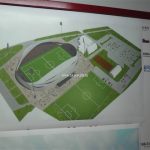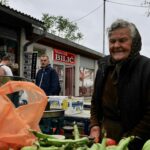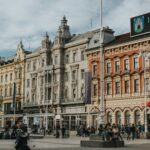The population of Sesvete has doubled in the past 20 years, but there have been no serious infrastructure projects to cater for the new inhabitants.
“Although in the beginning, a new look for Sesvete looked like a utopian idea, today, now that we have a project for renovating the former Sljeme factory and the City has expressed its support of the project, everything seems viable. We have an immense potential and entrepreneurial mentality, people living here do not wait for something to fall into their lap.”
That is how Ante Damjanovic and Radoslav Dumančić, initiators of the Green and Blue Sesvete association (Zelene i plave Sesvete), which has about 250 members, introduced their big venture on the eastern side of Zagreb, the biggest urban makeover in Zagreb in the past few decades, Jutarnji reports on September 9, 2017.
Sesvete has been squeezed into a small space and has had no structure, and the worst part is that there’s no centre that makes the place more alive and brings people together. The present “centre” looks like a transit zone between roads and a railroad with remains of factories (Sljeme, Badel, Končar, Termomehanika) and with an isolated neighbourhood of Jelkovec-Sopnica located nearby.
Sesvete is the only district in Croatia that has doubled its population in the past twenty years, but that has no normal playground, park, or promenade, and the police building and court are derelict. Sesvete is not a typical satellite town like Samobor and Velika Gorica, but it’s not a regular part of Zagreb either.
Liaison officer
The Lenuccis of Sesvete are going to be two members of the Faculty of Architecture, Bojan Baletić and Mladen Jošić, designers of the Borongaj student campus.
The New idea for Sesvete is based on transforming the industrial zone along the railway line into the centre, the Lower Town of Sesvete, with a park, urban neighbourhoods, pedestrian and bicycle paths; so the green Sesvete would come down from the slopes and join the blue Sava, three-and-a-half km away. Mayor Milan Bandić has recently established a Project Implementation Commission for the purpose of improving the quality of life in Sesvete, and Mirka Jozić, head of the City Office for Economy, labour and entrepreneurship, is Sesvete’s liaison officer with the city administration.
“We have suggested that the centre of Sesvete be moved south of the railroad, connecting the ‘old’ Sesvete and Jelkovec with its 11,000 inhabitants, to make a solid, dense zone where all new construction would take place in the next 20 years, and move the industry to the east, near Ikea.”
Although the general opinion in the past years was that the silos for cereals, three huge concrete vertical buildings near the railroad, should be torn down, the professors had different ideas for them:
“The silos have become a trademark of Sesvete. Why not save them, turn them into business or residential towers, say the State Archives – a similar project took place in Danish ports. They are tall enough so that they could be used to produce electricity from small wind power plants… Closed facilities could serve as a museum depot. We’ve talked with the Minister of Culture, Nina Obuljen, and she liked her idea, she wondered if there would be a place for restorers or conservators there,” professor Baletić reveals.
The project also envisions renovating the Sljeme meat industry and repurposing it into HUB, a new music school for 700 children, a health centre, police, a court, a park and a pedestrian zone.
The city has accepted the ideas of experts from the Faculty of Architecture. They will be given three thousand square meters of business space to create the conditions for 300 new jobs.
Mirka Jozić believes that the project could be realized in two years. “With this project, Sesvete will become a good neighbourhood, a centre to attract young people and companies whose interest is the new technology, innovations, wanting to share experiences and run their own business. We have come to the stage when we can start launching a design tender,” Mirka Jozić explains and adds that the City is planning to open a Plavi ured there, an office to help young entrepreneurs, as well as a technology park. “Studies have shown that Zagreb needs a 25,000 m2 technology park and at the moment there is 14,500 m2 of space at Zagreb Fair, so a part of it will be located in the former Sljeme factory. And two parts of the park would complement each other, not do the same things twice.
The association has begun negotiations to renovate Divjača, 800,000 m2 forest owned by the Church. “When the first rain falls, everything turns into mud, and if we renovate it, we could get a park bigger than Maksimir. The problem is that the Branimirova street should pass through the area in the future,” Mr Dumančić says and announces that two kilometres walking and cycling paths along the Vuger stream will be built this year.
The authors of the study have concluded that Sesvete has a huge chance for economic development, especially because it is located along two major European traffic directions, there is a railway corridor and the airport is near. This area has a growth potential that big international companies are looking for.
Mr Ilija Tokić, the president of the Supervisory Board of Tokić, part of the company that is the biggest automotive parts seller in Croatia, has seen the potential. “We have brought investors from Germany, Korea, many were interested, but gave up because of insecurity and bad infrastructure. The investment will not come because of natural beauty but because of favourable conditions and the possibility of returning the investment.”
Mr Tokić is involved in the project because, even though he will retire soon, he would like to contribute to the transformation of Sesvete and make sure that his four children will have a good place to live. Two years ago, he bought 26,000 m2 of business space from Baumax, hired 200 people and saw with his own eyes how the whole neighbourhood became alive overnight.
Other people involved in the project believe that Ikea is important, because, not only did it provide a barrier between Sesvete and a landfill, but it also provided room for future development and a ring road opening thousands of hectares of space in Sesvetski Kraljevec.
Excerpts taken and translated from Jutarnji list.










